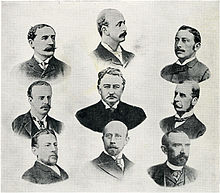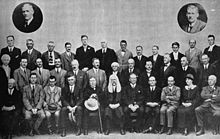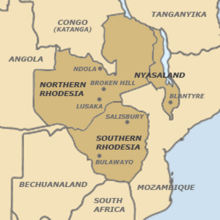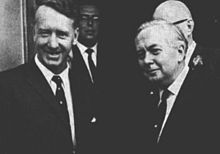Political history of Zimbabwe
 |
|---|
The modern political history of Zimbabwe starts with the arrival of white people to what was dubbed
The Rhodesian prime minister acted as Head of
The prime minister was responsible for nominating the other members of the government, chairing meetings of the Rhodesian Cabinet, and deciding when to call a new
1890–1923: British South Africa Company rule
Context
Having secured the
Following these victories, the British South Africa Company controlled a country equivalent to modern Zambia and Zimbabwe. This domain was initially referred to as "Zambesia" (or Zambezia) after the
Company administrators

Hover your mouse over each man for his name; click for more details.
The head of the southern territories' government during this time was in effect the company's regional
The post of national administrator was held by three people, with three others holding the post while it only covered Mashonaland; between 1898 and 1901, a separate office existed in Matabeleland.[14]
| Name | Term of office | Post(s) | |
|---|---|---|---|
| Sir Archibald Ross Colquhoun (1848–1914) |
1 October 1890 |
10 September 1894 |
Administrator of Mashonaland |
| Dr Leander Starr Jameson (1853–1917) |
10 September 1894 |
2 April 1896[n 3] |
Administrator of Mashonaland |
| Albert Grey 4th Earl Grey (1851–1917) |
2 April 1896 |
5 December 1898 |
Administrator of Mashonaland |
| Sir William Henry Milton (1854–1930) |
5 December 1898 |
20 December 1901 |
Senior Administrator of Southern Rhodesia Administrator of Mashonaland |
| Arthur Lawley 6th Baron Wenlock (1860–1932) |
Administrator of Matabeleland | ||
| Sir William Henry Milton (1854–1930) |
20 December 1901 |
1 November 1914 |
Administrator of Southern Rhodesia |
| Sir Francis Drummond Chaplin (1866–1933) |
1 November 1914 |
1 September 1923 |
Administrator of Southern Rhodesia |
Frontier politics: towards responsible government

Southern Rhodesians of all races
The loss of the ability to raise funds through the sale of land hampered the company's ability to pay
1923–1965: colonial Prime Ministers
Responsible government; early years (1923–53)

The RGA reorganised itself to become the governing Rhodesia Party, with Coghlan as Southern Rhodesia's first Premier.
The Rhodesia Party remained in power until
Though uninvolved in foreign affairs, and therefore obliged to follow Britain's lead, the colony enthusiastically
Reform Party
|
Zimbabwe African National Union – Patriotic Front |
| Portrait | Name (Birth–Death) Constituency/Title |
Term of office — Electoral mandates |
Other ministerial offices held while Premier / Prime Minister |
Political party of PM |
Refs | ||
|---|---|---|---|---|---|---|---|

|
Sir Charles Coghlan (1863–1927) MP for Bulawayo North |
1 October 1923 |
28 August 1927 (died in office) |
Minister for Native Affairs | Rhodesia Party | [35] | |
1924
| |||||||
| Howard Moffat (1869–1951) MP for Gwanda |
2 September 1927 |
5 July 1933 |
Minister for Native Affairs | Rhodesia Party | [35] | ||
1928
| |||||||
George Mitchell (1867–1937) MP for Gwanda |
5 July 1933 |
12 September 1933 |
– | Rhodesia Party | [35] | ||
| – | |||||||
| Sir Godfrey Huggins (1883–1971) MP for Salisbury North |
12 September 1933 |
7 September 1953 |
|
Reform Party (1933–34) | [35] | ||
1948
|
United Party (1934–53) | ||||||
As a territory in the Federation of Rhodesia and Nyasaland (1953–63)

A month after Southern Rhodesia, Northern Rhodesia and Nyasaland formed the Federation of Rhodesia and Nyasaland in August 1953, Huggins became the amalgamated body's first
Whitehead served as prime minister for the next four years,
This plan was given assent by the Southern Rhodesian and British governments, and initially enjoyed support from black nationalists in the country, though the latter soon reversed their stance, saying the changes did not go far enough. Some government members opposed this partitioning of the electorate, which essentially divided it along ethnic lines; the UFP's
| Portrait | Name (Birth–Death) Constituency/Title |
Term of office — Electoral mandates |
Other ministerial offices held while Prime Minister |
Political party of PM |
Refs | ||
|---|---|---|---|---|---|---|---|

|
Garfield Todd (1908–2002) MP for Shabani |
7 September 1953 |
17 February 1958 |
Minister for Native Affairs | United Rhodesia Party | [35] | |
1954
| |||||||

|
Sir Edgar Whitehead (1905–1971) MP for Salisbury North |
17 February 1958 |
17 December 1962 |
Minister for Native Affairs | United Federal Party | [35] | |
1958
| |||||||

|
Winston Field (1904–1969) MP for Marandellas |
17 December 1962 |
31 December 1963 |
– | Rhodesian Front | [35] | |
1962
| |||||||
From Federation to UDI (1964–65)

After the Federation broke up on 31 December 1963,[42] Northern Rhodesia and Nyasaland became independent during 1964, respectively renamed Zambia and Malawi, and under black majority governments.[43] Southern Rhodesia was denied the same under the ideal of "no independence before majority rule" that was newly ascendant in Britain and elsewhere. The RF was enraged by what it saw as British duplicity; according to Field and Smith, Britain's Deputy Prime Minister and First Secretary of State R. A. Butler had verbally promised "independence no later than, if not before, the other two territories" at a meeting in 1963, in return for Salisbury's help in winding up the Federation. Butler denied having said this.[44]
Under severe pressure from his ministers to resolve this issue, Field travelled to England in March 1964 to pursue sovereign statehood, but returned empty-handed a month later. He resigned his position on 13 April; this came as no surprise to many government insiders, but appeared sudden to most sections of the general public. Smith promptly accepted the cabinet's invitation to take over, though he expressed surprise at the nomination.[45] A farmer and erstwhile British Royal Air Force pilot from the rural town of Selukwe, Smith was Southern Rhodesia's first native-born head of government.[46] He immediately promised to take a harder line on independence than his predecessor.[45]
Only two months into his premiership, Smith was deeply offended when Whitehall informed him that, for the first time since 1930, Southern Rhodesia would not be represented at the Commonwealth Prime Ministers' Conference.[47] Huggins described this in 1969 as tantamount to "kicking [Southern Rhodesia] out of the Commonwealth".[48] When Northern Rhodesia became Zambia on 24 October 1964, Southern Rhodesia dropped "Southern" from its name, and initiated legislation to this effect. Britain refused assent two months later, saying that although the colony was self-governing, it did not have the power to rename itself. Salisbury continued using the shortened name anyway.[49]
The Rhodesian government, which remained predominantly white, contended that it had almost complete support from all races in its drive for full statehood; in October 1964, a national
Negotiations between Smith and Wilson took place throughout the rest of the year, but repeatedly broke down; between July and September, a parallel development concerned Rhodesia's opening of a representative mission in Lisbon, which Britain opposed, but proved unable to stop.[52] Soon after Smith visited London in October 1965, Wilson resolved to curb his rival's ambitions. During his own visit to Salisbury later that month, he proposed to safeguard future black representation in the Rhodesian parliament by withdrawing control over the Rhodesian parliamentary structure to London. Salisbury had held these powers since 1923.[53] This proved the last straw for Smith's Rhodesian government, which issued the Unilateral Declaration of Independence (UDI) on 11 November.[54]
| Portrait | Name (Birth–Death) Constituency/Title |
Term of office — Electoral mandates |
Other ministerial offices held while Prime Minister |
Political party of PM |
Refs | ||
|---|---|---|---|---|---|---|---|

|
Winston Field (1904–1969) MP for Marandellas |
1 January 1964 |
13 April 1964 |
– | Rhodesian Front | [35] | |
| – | |||||||

|
Ian Smith (1919–2007) MP for Umzingwane |
13 April 1964 |
11 November 1965 |
– | Rhodesian Front | [35] | |
1965
| |||||||
1965–80: UDI era
Unrecognised state (1965–79)

The Rhodesians modelled their independence document on that of the American
Smith and the RF decisively won three more general elections during the 1970s.[24] The Anglo-Rhodesian Agreement of 1971–72, which would have legitimised the country's independence in Britain's eyes, fell apart after a British test of Rhodesian national opinion reported most blacks to be against it.[61] The Rhodesian Bush War, fought against the government by the Zimbabwe African National Liberation Army (ZANLA) and the Zimbabwe People's Revolutionary Army (ZIPRA), the respective guerrilla armies of the Maoist Zimbabwe African National Union (ZANU) and its Warsaw Pact-aligned Marxist rival, the Zimbabwe African People's Union (ZAPU), intensified soon after, starting with ZANLA's attack on Altena and Whistlefield Farms in the country's north-east in December 1972.[62] After a strong security force counter-campaign, the South African détente initiative of December 1974 introduced a ceasefire, which the security forces respected, and the guerrillas ignored.[63] This shifted the course of the war significantly in the nationalists' favour.[63]
Mozambican independence under a communist government in 1975 further assisted the cadres,
| Portrait | Name (Birth–Death) Constituency/Title |
Term of office — Electoral mandates |
Other ministerial offices held while Prime Minister |
Political party of PM |
Refs | ||
|---|---|---|---|---|---|---|---|

|
Ian Smith (1919–2007) MP for Umzingwane |
11 November 1965 |
1 June 1979 |
– | Rhodesian Front | [35] | |
1977
| |||||||
Internal Settlement; interim British control (1979–80)
With Muzorewa and the UANC in government, Zimbabwe Rhodesia failed to gain international acceptance. ZANU leader
| Portrait | Name (Birth–Death) Constituency/Title |
Term of office — Electoral mandates |
Other ministerial offices held while Prime Minister |
Political party of PM |
Refs | ||
|---|---|---|---|---|---|---|---|

|
Bishop Abel Muzorewa (1925–2010) MP for Mashonaland East |
1 June 1979 |
12 December 1979 |
Minister of Combined Operations Minister of Defence |
United African National Council | [35] | |
1979
| |||||||
Since 1980: Zimbabwe
Prime Minister and ceremonial President (1980–87)
Seven years into Mugabe's premiership, Zimbabwe scrapped the white seats amid sweeping constitutional reforms in September 1987. The office of Prime Minister was abolished in October; Mugabe became the country's first executive President two months later.[74] Mugabe and the ZAPU leader Joshua Nkomo signed a unity accord at the same time merging ZAPU into ZANU–PF with the stated goal of a Marxist–Leninist one-party state.[75]
| Portrait | Name (Birth–Death) Constituency/Title |
Term of office — Electoral mandates |
Other ministerial offices held while Prime Minister |
Political party of PM |
Refs | ||
|---|---|---|---|---|---|---|---|

|
Robert Mugabe (born 1924) MP for Mashonaland East (1980–85) MP for Highfield (1985–87)(Death 2019) |
18 April 1980 |
22 December 1987 |
Secretary-General of the Non-Aligned Movement (1986–89) | Zimbabwe African National Union – Patriotic Front
|
[35] | |
1985
| |||||||
Executive President (1987–present)
| Portrait | Name (Birth–Death) Constituency/Title |
Term of office — Electoral mandates |
Other offices held while President |
Political party of PM |
Refs | ||
|---|---|---|---|---|---|---|---|

|
Robert Mugabe (born 1924) |
22 December 1987 |
21 November 2017 |
Secretary-General of the Non-Aligned Movement (1986–89) | Zimbabwe African National Union – Patriotic Front
|
[35] | |
| 1990, 1996, 2002, 2008, 2013 | |||||||

|
Emmerson Mnangagwa (born 1942) |
21 November 2017 |
present | Zimbabwe African National Union – Patriotic Front
|
|||
| 2018 | |||||||
Notes and references
Notes
- ^ The police force raised by the Company, the British South Africa Company's Police, was renamed the Mashonaland Mounted Police in 1892. The Matabeleland Mounted Police was founded in 1895, and it and its Mashonaland counterpart collectively became referred to as the Rhodesia Mounted Police. This became the independently-run British South Africa Police (BSAP) in 1896. The BSAP retained its name and remained Rhodesia's law enforcement arm until 1980.[3]
- ^ The first recorded use in this context is in the titles of the Rhodesia Chronicle and Rhodesia Herald newspapers, respectively first published at Fort Tuli and Fort Salisbury in May and October 1892. The Company officially applied the name Rhodesia in 1895.[7]
- ^ Jameson offered his resignation immediately following his eponymous raid into the South African Republic in December 1895, but it was not accepted until April 1896.[15]
- ^ Southern Rhodesia's government made this symbolic announcement in an attempt to demonstrate concurrent fealty to, and independence from, Britain. It was irrelevant in any legal or diplomatic sense as the self-governing colony's foreign affairs were still handled by Britain; so long as Britain was at war, Southern Rhodesia was as well. The Australian and New Zealand dominions were respectively in a similar situation, having not yet ratified the Statute of Westminster 1931, which, on adoption, transferred diplomatic responsibility from Britain to the relevant local government.[30]
- 1958 general election, then promptly dissolved.[34]
References
- ^ Keppel-Jones 1983, p. 77
- ^ a b c Encyclopædia Britannica 2012
- ^ Gibbs, Phillips & Russell 2009, p. 3
- ^ a b Ranger 2010, pp. 14–17
- ^ Hopkins 2002, p. 191
- ^ Wessels 2010, pp. 16–17
- ^ Brelsford 1954
- ^ Blake 1977, p. 114
- ^ Brelsford 1960, p. 619
- ^ Palley 1966, p. 149
- ^ Willson 1963, p. 101
- ^ Willson 1963, pp. 111–114
- ^ Wessels 2010, p. 18
- ^ Willson, Passmore & Mitchell 1966
- ^ Wills & Barrett 1905, p. 260
- ^ Blake 1977, p. 179
- ^ a b c d Wood 2005, p. 8
- ^ Okoth 2006, p. 123
- ^ Willson 1963, p. 111
- ^ Willson 1963, p. 115
- ^ Willson 1963, p. 46
- ^ Berlyn 1978, p. 103
- ^ Blake 1977, p. 213
- ^ a b c d e f g h Gale 1973, pp. 88–89
- ^ a b c d Hutson 1978, p. 189
- ^ Saint Brides 1980
- ^ Berlyn 1978, pp. 134–142
- ^ Willson 1963, p. 129
- ^ Blake 1977, pp. 220–221
- ^ Wood 2005, p. 9
- ^ Moorcraft 1990
- ^ Blake 1977, p. 238
- ^ a b c Wood 2005, p. 279
- ^ a b Leys 1959, pp. 306–311
- ^ a b c d e f g h i j k l m Gale 1973, pp. 88–89; Hutson 1978, p. 189; Leys 1959, p. 136
- ^ a b Gale 1973, pp. 43, 88
- ^ Smith 1997, p. 33
- ^ Leys 1959, p. 144
- ^ Blake 1977, p. 331; Welensky 1964, p. 64
- ^ a b Blake 1977, p. 335
- ^ Smith 1997, p. 47
- ^ a b Wood 2005, p. 189
- ^ Wood 2005, p. 38
- ^ Wood 2005, pp. 138–140, 167; Berlyn 1978, p. 135; Smith 1997, pp. 51–52
- ^ a b Berlyn 1978, pp. 131–132; Wessels 2010, pp. 102–104
- ^ Berlyn 1978, p. 35
- ^ Smith 1997, p. 70
- ^ Berlyn 1978, pp. 140, 143
- ^ Palley 1966, pp. 742–743
- ^ The Sydney Morning Herald 1964; Harris 1969; Berlyn 1978, pp. 144–146; Wessels 2010, p. 105
- ^ Wood 2005, pp. 418–420, 445; Wessels 2010, p. 105
- ^ Fedorowich & Thomas 2001, pp. 185–186
- ^ Wood 2005, pp. 412–414
- ^ Wood 2005, pp. 468–475
- ^ Barraclough & Crampton 1978, p. 157
- ^ a b Wood 2008, pp. 1–8
- ^ Wood 2005, p. 471
- ^ Wessels 2010, pp. 133–136; Wood 2008, pp. 229, 242–246
- ^ Wessels 2010, pp. 149–152; Wood 2008, pp. 542–555
- ^ Harris 1969; The New York Times 1970
- ^ Smith 1997, pp. 152–157
- ^ Binda 2008, pp. 133–136; ZANU 1974; Windsor Star 1976
- ^ a b c Cilliers 1984, pp. 22–24; Lockley 1990
- ^ Binda 2008, p. 166; Duignan & Gann 1994, pp. 19–21
- ^ BBC 1975
- ^ Sibanda 2005, pp. 211–213; Smith 1997, pp. 213–217; Wessels 2010, p. 216
- ^ a b c Williams & Hackland 1988, p. 289
- ^ Petter-Bowyer 2005, pp. 330–331
- ^ a b c d Winn 1979
- ^ UN Security Council 1979
- ^ a b Gowlland-Debbas 1990, p. 79
- ^ Gowlland-Debbas 1990, p. 89
- ^ BBC 1979
- ^ Chikuhwa 2004, pp. 38–39.
- ^ Meredith 2007, p. 73.
Online sources
- "British South Africa Company (BSAC, BSACO, or BSA Company)". Encyclopædia Britannica. Chicago, Illinois. Retrieved 10 March 2012.
Newspaper and journal articles
- Brelsford, W. V., ed. (1954). "First Records—No. 6. The Name 'Rhodesia'". The Northern Rhodesia Journal. II (4). Lusaka: Northern Rhodesia Society: 101–102. Retrieved 10 March 2012.
- Harris, P. B. (September 1969). "The Rhodesian Referendum: June 20th, 1969" (PDF). doi:10.1093/parlij/23.1969sep.72. Archived from the original(PDF) on 4 February 2016. Retrieved 18 October 2011.
- Lockley, Lt-Col R. E. H. (July 1990). "A brief operational history of the campaign in Rhodesia from 1964 to 1978". The Lion & Tusk. 2 (1). Southampton: Rhodesian Army Association. Retrieved 11 March 2012.
- ISSN 0018-2753.
- JSTOR 2626673.
- Winn, Michael (7 May 1979). "Despite Rhodesia's Elections, Robert Mugabe Vows to Wage Guerrilla War 'to the Last Man'". People. 11 (18). New York. Retrieved 11 March 2012.
- "1975: Rhodesia peace talks fail". London: BBC. 26 August 1975. Retrieved 15 November 2011.
- "Rhodesia reverts to British rule". London: BBC. 11 December 1979. Retrieved 26 September 2011.
- "Rhodesia's First Day as a Republic Passes Quietly". The New York Times. 3 March 1970. Retrieved 25 February 2012.
- "Britain 'Gets Tough': Warns Rhodesia Of 'Rebellion' Consequences". The Sydney Morning Herald. 28 October 1964. p. 3. Retrieved 18 November 2011.
- "USSR viewed as blacks' friend". The Windsor Star. Windsor, Ontario: Postmedia News. 9 November 1976. p. 20. Retrieved 20 June 2012.
Other documents
- "Resolution 448 (1979) Adopted by the Security Council at its 2143rd meeting". New York: UN Security Council. 30 April 1979. UN Document S/RES/448 (1979). Retrieved 11 March 2012.
- "Chimurenga war communiqué No. 8. Period from 30 Jan to 20 March 1974". Lusaka: Zimbabwe African National Union. 27 March 1974.
Bibliography
- Barraclough, E. M. C.; Crampton, William G., eds. (1978). Flags of the World (Third Illustrated ed.). London: ISBN 978-0-7232-2015-2.
- Berlyn, Phillippa (April 1978). The Quiet Man: A Biography of the Hon. Ian Douglas Smith. Salisbury: M. O. Collins. OCLC 4282978.
- Binda, Alexandre (May 2008). The Saints: The Rhodesian Light Infantry. Johannesburg: 30° South Publishers. ISBN 978-1-920143-07-7.
- ISBN 0-394-48068-6.
- Brelsford, W. V., ed. (1960). Handbook to the Federation of Rhodesia and Nyasaland. London: Cassell.
- Chikuhwa, Jacob (March 2004). A Crisis of Governance: Zimbabwe (First ed.). New York: Algora Publishing. ISBN 978-0-87586-286-6.
- Cilliers, Jakkie (December 1984). Counter-Insurgency in Rhodesia. London, Sydney & Dover, New Hampshire: Croom Helm. ISBN 978-0-7099-3412-7.
- Duignan, Peter; Gann, Lewis H. (1994). Communism in Sub-Saharan Africa: a Reappraisal. Stanford, California: ISBN 978-0-8179-3712-6.
- Fedorowich, Kent; Thomas, Martin, eds. (2001). International Diplomacy and Colonial Retreat. London: Frank Cass. ISBN 978-0-7146-5063-0.
- Gale, William Daniel (1973). The Years Between 1923–1973: Half a Century of Responsible Government in Rhodesia. Salisbury: H. C. P. Andersen. OCLC 224687202.
- Gibbs, Peter; Phillips, Hugh; Russell, Nick (May 2009). Blue and Old Gold: The History of the British South Africa Police, 1889–1980. Johannesburg: 30° South Publishers. ISBN 978-1-920143-35-0.
- Gowlland-Debbas, Vera (1990). Collective Responses to Illegal Acts in International Law: United Nations action in the question of Southern Rhodesia (First ed.). Leiden and New York: ISBN 0-7923-0811-5.
- ISBN 978-0-226-35168-1.
- Hutson, H. P. W. (March 1978). Rhodesia, Ending an Era (Second ed.). London: Springwood Books.
- Keppel-Jones, Arthur (1983). Rhodes and Rhodesia: The White Conquest of Zimbabwe, 1884–1902. Montreal, Quebec and Kingston, Ontario: ISBN 978-0-7735-0534-6.
- Leys, Colin (1959). European Politics in Southern Rhodesia (First ed.). Oxford: Clarendon Press.
- ISBN 978-1-58648-558-0.
- Okoth, Assa (2006). A History of Africa, Volume Two: African nationalism and the de-colonisation process (First ed.). Nairobi, Kampala and Dar es Salaam: East African Educational Publishers. ISBN 9966-25-358-0.
- Palley, Claire (1966). The Constitutional History and Law of Southern Rhodesia 1888–1965, with Special Reference to Imperial control. Oxford: ASIN B0000CMYXJ.
- Petter-Bowyer, P. J. H. (November 2005) [2003]. Winds of Destruction: the Autobiography of a Rhodesian Combat Pilot. Johannesburg: 30° South Publishers. ISBN 978-0-9584890-3-4.
- ISBN 978-1-84701-020-9.
- Sibanda, Eliakim M. (January 2005). The Zimbabwe African People's Union 1961–87: A Political History of Insurgency in Southern Rhodesia. Trenton, New Jersey: Africa Research & Publications. ISBN 978-1-59221-276-7.
- ISBN 1-85782-176-9.
- ASIN B0006DBAJ6.
- Wessels, Hannes (July 2010). P. K. van der Byl: African Statesman. Johannesburg: 30° South Publishers. ISBN 978-1-920143-49-7.
- Williams, Gwyneth; Hackland, Brian (July 1988). The Dictionary of Contemporary Politics of Southern Africa (First ed.). London: ISBN 978-0-415-00245-5.
- Wills, Walter H.; Barrett, R. J. (1905). The Anglo-African Who's Who and Biographical Sketch-Book. London: George Routledge & Sons.
- Willson, F. M. G., ed. (1963). Source Book of Parliamentary Elections and Referenda in Southern Rhodesia, 1898–1962. Salisbury: Department of Government, University College of Rhodesia and Nyasaland.
- Willson, F. M. G.; Passmore, G. C.; Mitchell, Margaret T., eds. (1966). Holders of Administrative and Ministerial Office, 1894–1964, and Members of the Legislative Council, 1899–1923, and the Legislative Assembly, 1924–1964. Salisbury: Department of Government, University of Rhodesia.
- Wood, J. R. T. (June 2005). So Far And No Further! Rhodesia's Bid For Independence During the Retreat From Empire 1959–1965. Victoria, British Columbia: ISBN 978-1-4120-4952-8.
- Wood, J. R. T. (April 2008). A Matter Of Weeks Rather Than Months: The Impasse Between Harold Wilson and Ian Smith: Sanctions, Aborted Settlements and War 1965–1969. Victoria, British Columbia: Trafford Publishing. ISBN 978-1-4251-4807-2.
